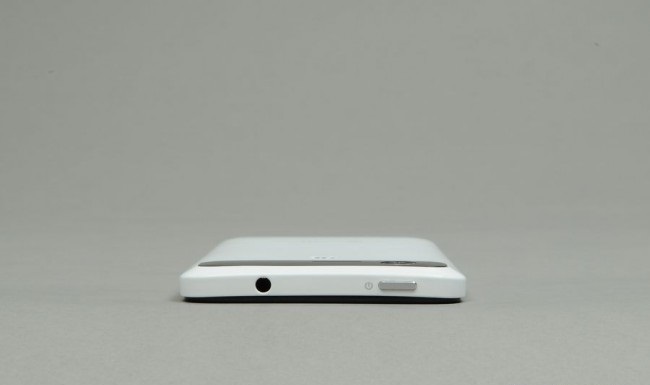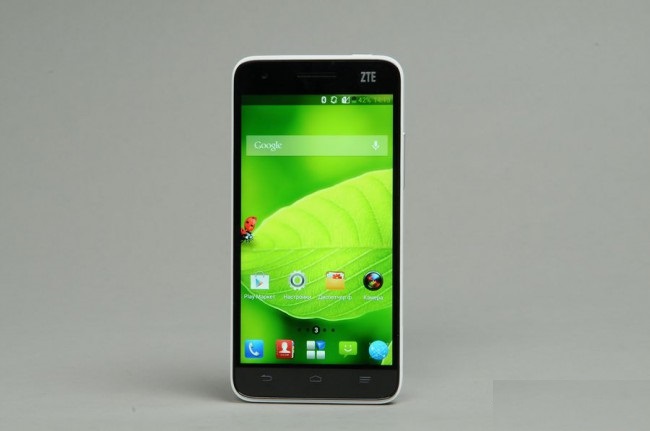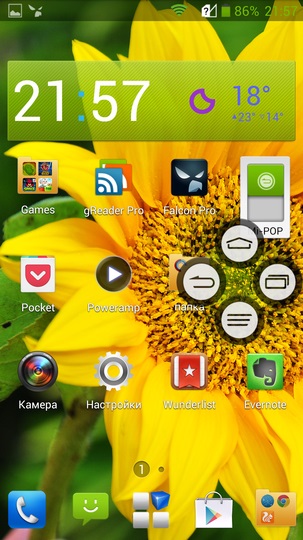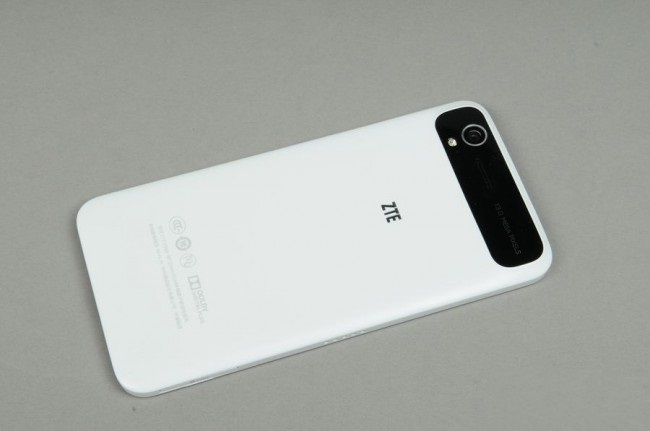ZTE is known to most consumers as a manufacturer of smartphones budget and mid-price segments, which are often sold on the carrier markets. However, the portfolio of carrier-budget is not limited to vehicles. Gradually, the company enters new markets and manufactures vehicles in various price categories. With one of them – ZTE Grand S, we will introduce today.
Housing ZTE Grand S is made of frosted white plastic. On the back cover it dilutes black glossy insert the camera lens and speaker. The very smooth plastic, not soft-touch, but rather “tenacious.” The feeling that the machine can slip out of your hands completely absent. Assembling the unit is great – a one-piece body ensures that no squeaks and play.
Case dimensions are comparable to most other five-inch smartphone. Location of Controls standard – the power button and 3.5mm jack on top, the volume rocker on the right side, micro-USB connector at the bottom. At the ends of the cover plate is a slot for a SIM card (standard size) and memory card. The plugs are sitting pretty tight, and in their life there is no doubt. Below the screen are three touch-sensitive keys System (“back”, “home” and “menu”). In the hand unit is comfortable to contribute to it as pleasant to the touch plastic and rounded corners. The only drawback of ergonomics – is the power key, to unlock the device had to change his grip. The keys have a clear course and project slightly above the surface, making them easy to find by touch.
Screen
In ZTE Grand S installed a five-inch matrix with a resolution of 1920×1080 pixels. Natural color reproduction, thanks to the high resolution picture looks very smooth. The viewing angles are close to the maximum deviation in the picture does not fade, the colors are not inverted. Due to the lack of an air layer between the matrix and the glass gives the impression that the image is on the surface of the cover glass. In bright sunlight the screen fades, but still readable.
The minimum brightness level of 25.3 cd/m2 – a bit overkill for reading in the dark. The average level of brightness – 177.7 cd/m2, the maximum – 367 cd/m2. Automatic brightness control is working properly. In the upper left corner, a LED that indicates the status of the charging process and reports of missed events.
General impressions of the screen (image quality) – a purely positive, but there are a few comments. Oleophobic coating at the screen is not, as a result, he is well collects fingerprints, which are quite difficult to remove. Along the edges of his frames frame, extending above the screen at a fraction of a millimeter. It protects the screen from scratches when you put the device face down, she’s a little cut into the ear during a call – especially when it is felt long conversations. The sensitivity of the screen seemed a bit low, this was particularly noticeable in the upper area when removing the strip notifications – most likely it is a feature of the test sample.
The software part of the shell
The smartphone runs on the Android operating system version 4.1.2. Standard launcher and icons are replaced own. The maximum number of desktops – 9, it is possible to select an animation when changing desktops. The main differences from the standard Android interface hiding in the scheme of the lock screen notifications and stripes.
To unlock the smartphone should hold your finger on the “lock” for about a second, when you hold something around there like a luminous band – as if the end of the fast-moving clock hands leaves its mark. If on the lock screen to return the gesture pinch-to-zoom, will be six shortcuts for quick access. To do this, always having to use the second hand, which is questionable in terms of ergonomics. Two labels (unlock and sound modes) can not be changed, the rest you can assign any of your installed applications, or leave them blank. You can not change the number of labels.
The string contains two tabs notifications – notifications and switches (labels), you can navigate between them swipe. The tab with the labels can be up to eight switches and up to eight application shortcuts. Long press on the label does not translate into the appropriate setting item.
The scheme of the notification bar is borrowed from some popular custom firmware. If you pull the notification bar, spending on the left side of the screen, then you get to notice, on the right – fast settings and shortcuts to applications. Unfortunately, you can configure this functionality is not provided.
The manufacturer has arranged another addition, calling it a Mi-POP. In fact, it is analog on-screen control buttons that are displayed on top of any application. By default, the only visible button “back”. If it is to pull a little to the side, she turns into a diamond of four buttons – “back”, “home”, “menu” and “recent applications.” Mi-POP is always docked to the selected edge of the screen and the desktop widget can be taken to its rapid inclusion. Such control can be useful if you are uncomfortable to reach for the standard control buttons.
Application Menu supports various sorting options. It is possible to create folders and hide individual application.
The manufacturer presets the entire three browsers – Standard Android, Chrome and UCBrowser. The latter is the brainchild of Chinese developers with enough good functionality (gesture commands, support for themes and extensions, trimming the width of the text and images to fit the screen, and many others).
To enter text, pre-installed keyboard TouchPal. It supports input swure, has many options, but it is better to use instead Stock keyboard or replace analog.
Dialer support T9 search for contacts. Keyboard keypad is optimized for screen size – its size can be slightly reduced and docked to the left or right side for easy one-handed operation.
Overall impression of the shell is quite good, but there is a certain sense of incompleteness that suggests the idea that it would be better used here stock interface. Everything else, sometimes you can find the localization of flaws (such as “lose” instead of “reset”).
The hardware platform, memory
The smartphone is based on a quad-core platform Qualcomm Snapdragon S4 Pro (APQ8064 + Adreno 320), supplemented with 2 GB of RAM. On the same platform built many other flagships of the beginning of 2013 (for example, Sony Xperia Z).
The pre-installed memory of 16 GB. Two are reserved for the application, 11 – for user data. It is possible to move applications to the internal memory card. After the download is up to 1.2 GB of RAM.
Launching applications is quick, large amount of RAM allows you to keep running a lot of programs. Today’s games are no problem. At the same time there are braking shell desktops scrolled sometimes with a slight delay – the effect of the lack of optimization.
As on other devices based on SnapdragonS4 Pro, problems with the Wi-Fi or GPS does not arise – both have good sensitivity, the unit quickly finds the satellites.
Camera
The smartphone 13 megapixel main camera, front – 2MP. The camera application has a simple user-friendly interface with a lot of different settings and modes.
Starts, the camera focuses and shoots quickly enough. About the quality of pictures you can say one thing – it’s average is at an acceptable level. This applies to both images in a bright sunny day and artificial light. The presence of HDR mode does not help the situation – the picture quality and color remain about the same, but at the time the image is saved a few seconds you have to look at the words “conservation”. The front camera gives a good picture.
The battery operating time
Before the announcement of the network there were a lot of rumors that the Grand S is one of the thinnest devices with a 5-inch FullHD screen. As a result, for his appearance, he won iFDesign. But it seems to have achieved this at the cost of reducing the capacity of the battery – the battery inserted in the smart phone on 1780 mAh. Operation of the smartphone revealed that the average load (half-hour conversation, reading tape Twitter and some news during the day, hour and a half, playing games or watching videos, listening to music hour) smartphone can withstand the light of day. A more active use Grand S will ask to charge much faster.
To listen to the music we used a standard player, the volume on the value of 12 out of 15, the MP3 files with a bitrate of 320 kbit / s. In the read mode disables all wireless communications, including data transmission in a mobile network, and the display brightness set to 50%. Navigation includes a route in Google Navigation app. Brightness exhibited 50%, all data communication modules disabled. When playing a video display brightness set to 50%, the volume level on level 12 of a possible 15. A video file format MKV, resolution 1024h432 points, frame 24. When playing video from Youtube display brightness set to 50%, the volume level at 12 out of 15 possible levels.
Speakers, calls, multimedia
The smartphone uses software processing of sound Dolby Digital Plus. It has a positive impact both on the sound of the external speaker, and the quality of music in headphones.
Ringer speaker is loud, has a clear sound. If you put the unit on a table or sofa screen up, the speaker is covered and its volume decreases significantly, just as the speaker is muted when the smartphone is in your pocket. This can be a significant disadvantage, given the weak vibration – while walking in the pocket of his pants, he was not there. The sound quality of the headphones pleased – programmatically add some “bulk” sound, and the sound is clean, no background noise. For games and videos in the settings can include additional vibration, but in our sample, this functionality is not working.
The earpiece has an average volume level, in a noisy environment sometimes you want to add volume. Voices sounded natural interlocutors. When an outgoing call when a call connects your smartphone vibrates slightly, turn off the vibration can not be.
The smartphone has a FM-radio reception quality and good sensitivity.
The results
ZTE Grand S – smartphone, which leaves a little mixed feelings. On the one hand, we have a good-looking, high-quality assembled device with excellent FullHD screen and productive platform, on the other – a weak autonomy and a sufficient number of small childhood diseases that can fix with latest firmware release. In such situations, the cost always plays a crucial role. The smartphone should be available for sale at the end of October, the cost will be approximately 3200grn. At that price, he had time to fall in price is between Sony Xperia ZL, Lenovo K900 and Chinese smartphones with FullHD screens on the platform MediaTek MTK6589. The attractive price tag is sure to attract consumers, and with the sole objective disadvantage – low autonomy, you can simply accept it.
Liked
– Quality screen
– Slim and lightweight
– Productivity Platform
– The quality of sound
Do not like it
– Autonomy
– Slight vibration
Read another very interesting article about alternative energy of the Sun, water and air.















my phone was unable to start . Only showing ZTE Home page. Firmware is needed to be re-installed.Please advise me.